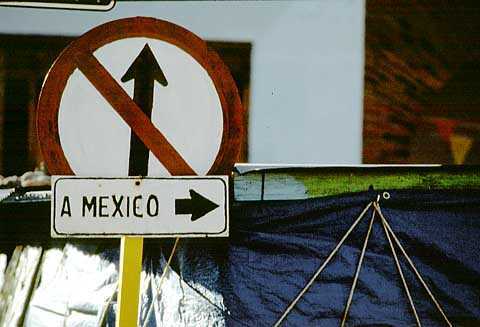Westwords

This is a simple story about a tope and a seat belt.
I am an advocate of slowing to almost a stop when speed bumps appear high enough to scar mufflers and rattle dental repairs. I believe in seat belts. At my age, I need all the stability I can get.
That said, many topes have come and gone and three seat-belt stories came and went but did little to strengthen my commitment and cement my conviction. The fourth rang a bell!
My very own survey says use of seat belts has become more common in Mexico. I would guess all newer cars, some older ones and maybe half the big city cabs are properly equipped. Authorities are enforcing the law — occasionally.
My most recent taxi ride in Mexico City was very exciting. I bumped my nose on the back of the driver’s seat. A man in a van turned right in front of us and three other lanes of rapid transit.
It was an absolute necessity that my driver jam on the brakes. Tires screamed in protest beside and behind us. Horns blew. He uttered a few words I did not comprehend. My Spanish is weak.
The little van made it. I suppose it is obvious I survived.
When I regained my composure and was able to sit back, I took inventory. Thank goodness there was the great protector, Christ on the little gold cross, swinging on a chain from the rear-view mirror. There were no seat belts.
Story 2: A television show purchased a very used Boeing 727, equipped it with cameras, sensors and test dummies with breakable bones, launched it with auto controls and smashed the plane into the Sonoran desert. You may already know the conclusions: The front 11 rows took a terrible hit. Had there been people in the seats, they would have died.
On back in the plane, G forces dropped by half. Experts said 78 per cent of the passengers would have had a chance to survive.
Surprise, surprise: The odds went way up for the smart dummies wearing seat belts.
Story 3: Not long ago, in San Luis Potosi, nine people, including two youngsters, were killed and 11 others injured when two pickup trucks collided on the highway between Villa Juarez and Cerritos. It was 7:30 in the morning and there was thick fog. Officers said excessive speed might have been a factor.
Mexicans use pickup trucks as shuttle buses. It is not uncommon to see a dozen or more passengers in the back of a pickup. Some are workers going to or coming from their jobs. Some are students going to or coming from school. Some are soccer teams. Some are children just along for the ride.
Seat belts? Most often there are no seats. The crowd stands and people hold on to each other when the pickup swings around a curve. Big girls and pretty women get the best of care.
If there is less congestion, riders often sit on the spare tire or on the sides of the truck and make me think they will soon fall off. It appears people of wisdom sit on the floor.
I was saddened to hear about the deadly crash. The old pickup truck that lives across the street from us occasionally hauls a crowd in the back, most often children. It could have been them.
Story 4: I always wear my seat belt when zipping around and about Mexico in our 1998 Volkswagen bug, purchased new when we got serious about going international. My safety routine is to buckle up before starting the engine.
On one particular day, I helped Sarah fasten her seat belt but, for some inexplicable reason, did not secure mine. I suppose age does take a toll.
A few kilometers from our home, I slowed to sneak over a tope. As fate would have it, a few feet off to the side stood a traffic officer. He motioned me to pull over.
In excellent English, he asked if I knew why he had stopped me. I did not. He pointed and said “seat belt.”
Oh no, said I.
The policeman actually smiled. I think he believed it was an oversight instead of a bad habit.
I asked, politely, why he nailed me and allowed those three cars filled with his countrymen to bounce over the same tope and go on their way.
He smiled again and said “I wanted to practice my English.”
The fine in Jalisco for seat-belt violations can range from 672 pesos up to 2018. I received the minimum ticket. By paying promptly, I got a 50 per cent discount. The penalty of waiting in line to give away money was more than enough to get my undivided attention. I don’t think I will make that mistake again.
Part of my repentance is this story. Hooray for Mexican seat belts!
Mexican law requires drivers and front-seat passenger to wear seat belts. Passengers in the back supposedly have a choice. Children under 12 are advised to sit in the back seat. Children under five are supposed to be secured in a special seat fastened by the seat belt in the back.
In real life, that rarely happens.
The World Health Organization says Mexico scores poorly on traffic safety. Macho dispositions, the myth of indestructibility, a lack of driver education and mediocre enforcement are said to be the basic concerns. Awareness campaigns may or may not make a difference.
Once upon a time, a school-based, bilingual project was created to increase seat belt use among families living along the Texas-Mexico border. It included more than 2000 students in 110 classrooms.
Results? Seat belt use increased by 10 per cent among children. There was no noticeable change in adult habits. One community actually had a slight drop in driver seat-belt usage but not enough to spoil the stats.
I have data from three rounds of a recent road safety study in Guadalajara, Zapopan and León. Overall seat-belt use was a surprising 44.3 per cent. Police take credit. Restraints for little people ranged from 7.9 to 17.4. That is the fault of parents. Police do not accept blame.
Seat belts supposedly reduced the severity of traffic accident injuries by 11 percent. I expected better results but the hospital explanation was city crashes are generally less severe than higher speed highway wrecks, thus less to be gained.
Safe Kids Mexico, a do-good group funded in part by Johnson and Johnson, is dedicated to protecting children. Cars are bad news. Safe Kids says every day in Mexico, an average of six children die on streets and roads, most while traveling to and from school.
This really hurts: Less than 13 percent of Mexican families impose seat-belt rules.
Do us all a favor. Ask people to buckle up. The nice policeman may be back at the speed bump. You never know, he might be doing Spanish today.


What is the law of a passenger sitting next to the driver of a pickup that has a front bench seat
To the best of my knowledge this would depend on the driving regulations and laws in each state. Best to ask locally or on a forum or Facebook page related to the state in question. Safe travels, TB.
As someone was born and raised in Canada I have to warn of the slippery slop about passing more and more laws concerning safety. It may sound great at time but keep in mind with more laws you create the less freedom you have. Here in Canada almost EVERYTHING you do may be a violation of some technical rule. Mexico should not fall into this trap. Laws should be created so that people don’t harm other people. Laws should not be created for protect people from themselves (ie: seat belt or helmet laws).